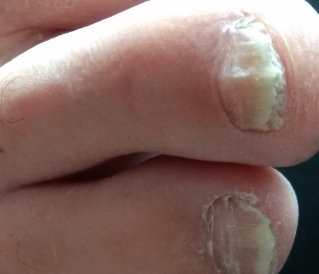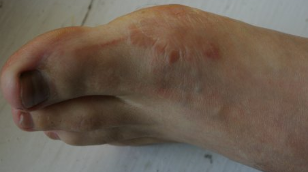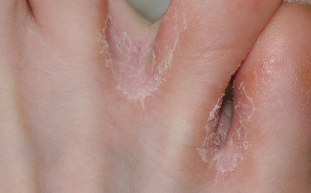If you recognize the fungus at an early stage and time to begin treatment, there is a high probability of quick recovery using the minimum number of antifungal drugs, most of which are dangerous to health (especially to the liver) during long-term therapy. Unfortunately, not always and not everyone is able to respond promptly to the first signals of the emergence of fungal infections, as the symptoms at the initial stage is very similar to a harmless skin manifestations. I know the feeling, when he discovered a yellow spot on the nail plate on the toe and the first thoughts that come to mind – nothing will be cut, will grow healthy and clean nail or hit somewhere soon. Or there was a small peeling in the interdigital folds, which in 90% blamed on dry skin and begin to treat moisturizer. But all these "harmless" manifestations often lurks the familiar and hated fungus feet.
Predisposing factors and sources of contamination

Pregnancy can cause the development of fungal diseases, because women in this period can be observed a sharp decrease in immunity and hormonal disturbance.
Fungus, like many diseases cannot develop itself – for its appearance and progression of the necessary enabling environment. There are a number of factors and related diseases that provoke the appearance of this disease:
- a sharp decline in immunity;
- the absence or violation of personal hygiene;
- excessive sweating;
- diabetes mellitus;
- obesity;
- flat feet;
- vascular disease of the lower extremities;
- the constant bruises and wounds;
- surgical intervention, etc.
We have listed the most popular causes of fungus of the feet, but even improper diet or long-term use of antibiotics can also cause the development of mycosis.
Infection most often occurs after using the shoes of the sick person or the public showers. In recent years there has been a rapid increase in the spread of fungal infection through manicure instruments. Sources of infection can be attributed:
- personal hygiene of the sick person (loofah, pumice stone);
- things of an infected person (socks, shoes, Slippers, pants);
- floors (especially hardwood) in baths, showers, gyms.
Pathogens of fungus on the feet is very resistant to the environment differ in that they can survive for long periods in a latent condition in wood, towels, socks. Acute – spring and autumn.
How to recognize foot fungus at the initial stage?

Here experienced dermatologists recommend to pay attention not only to external but also internal characteristics. Have you noticed that they all go to the baths, pools, sunbathe on the beach, but the fungus only affects individual people? The fact is that its development requires an enabling environment – lower the body's resistance. Such a condition might be observed in the presence of comorbidities or recent medical events, during which used antibiotics or hormones.
Now let's talk about the manifestation of the fungus on the skin of the feet. The main symptoms include:
- cracks in the interdigital folds;
- peeling between the toes;
- hardening of the skin on the heels;
- coming skin on the feet, toes;
- deformity of the nail plate (thickening or thinning);
- discoloration of nails (yellow, brown, black);
- redness and swelling of the feet;
- the appearance of red spots on the thighs and the inside of the legs;
- scales on the entire surface of the foot;
- itching of varying intensity (depending on the location and cause);
- fetid smell (often occurs in people who suffer from excessive sweating).
With deep mycosis can be observed the appearance of vesicles, crusts and cracks, which are accompanied by severe itching and pain. In some cases, lesions are found in places that because of the severe pain there is no possibility to become on the foot. This can lead to temporary disability and problems with movement.
Varieties and classification
As you already know, fungal infections can be caused by various pathogens on this basis, may vary the localization of the lesions. Most often the fungus on the feet can be caused by:
- dermatomycosis;
- Candida a fungal infections;
- deep mycoses.
All fungal infections of feet are now considered independent diseases, which are caused by various pathogens and localized on various parts of the feet, but they are all United by one name – the fungus on the feet. The most common ones:
- Rubrofitiya stop. Approximately 60% of all mycoses of the feet. Is characterized by high contagiousness and prevalence among certain segments of the population. The initial stage rubromikoza stop characteristic lesions of the fingers between the folds on the legs. Further, the process involves the sole and inner side of the foot. Defeat nail plastic for rubrofitii is observed in every third patient. Quite often combined with a fungus on the hands, especially in generalized rubromikoze.
- Epidermo mycoses. These include two separate diseases – Epidermofitiya stop and Epidermofitiya inguinal-femoral folds. In both cases, the lesions are localized on the legs. Epidermofitii stop characteristic lesion of folds between toes, the soles and top of the foot. Less process goes on the nails (usually I and V toes). The lesions covered with scales and crusts. There is itching of varying intensity. In acute cases, there may be General malaise and headache. Inguinal Epidermofitiya appears as large scaly patches in the groin, on the inner side of the legs, thighs, and perianal region. Lesions may reach the size of large plates, accompanied by a slight itching, peeling and swelling.
- The onychomycosis. Every year the prevalence of fungal nail infections is steadily increasing. Only now (according to the statistics of mid-2016) in 10-18% of Russians diagnosed with onychomycosis of the nails of varying severity. Of great importance in their development are environmental and social factors. Also at risk are people who have problems with cardiovascular, immune and endocrine system. Men suffer from 1.3 times more often than women. Children onychomycosis is very rare, the peak prevalence in people aged 50 to 70 years.
- Candidiasis. Rare, but still there are cases of lesions of the foot by the fungus Candida. In rare cases, candidal balanoposthitis can be spread from genitalia to the perianal area and inguinal-femoral folds. A little more yeast-like fungi occur on the nails. At the initial stage marked tenderness of the nail fold, when pressed on which can stand out the pus. Over time, its color becomes brown hue.
There are still rubrofitiya smooth skin, but the lesions in her uncommon legs. But rubromikozu in the groin is characterized by the lesion of the internal part of the leg red spots.
Treatment and prevention
Diagnosis of athlete's foot includes an overview of the clinical picture, the taking of scrapings from the lesions, the microscopic examination (find thread of mycelium) and bacterial seeding to determine the culture of mushrooms. Before visiting the doctor do not treat the lesions by any means! Differential diagnosis is carried out with eczema, rashes and contact dermatitis.
Treatment Epidermofitii and rubrofitii in the groin is performed using topical treatments (usually Clotrimazole). The Outlook is positive, the duration of therapeutic interventions rarely exceeds one month. As prophylaxis it is recommended that treatment of lesions of the alcohol-containing solutions, the presence of itching can be prescribed antihistamines.

More difficult is the case with athlete's foot and onychomycosis, as even the initial stages they are very difficult to treat and prone to recurrence. The most effective is the combination of external and systemic medications, strict adherence to dosage, personal hygiene and disinfection rules. Well-proven combination in capsules diflucan and terbinafine in the form of ointment (treatment of lesions of the 2P/d for the month). Much attention in the fungus of the feet placed on the treatment of shoes and socks, which can cause relapse. Socks preferably be boiled or washed at 90 degrees, the soles and shoes inside should be treated with a solution of chlorhexidine.
And most importantly remember that today is a fungus found in its early stages, can be treated successfully with modern medications, but running onychomycosis and athlete's foot can be treated months and even years.
















